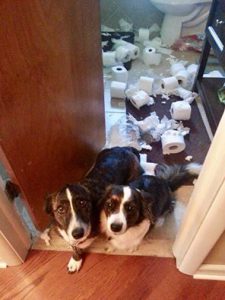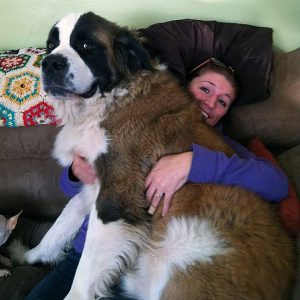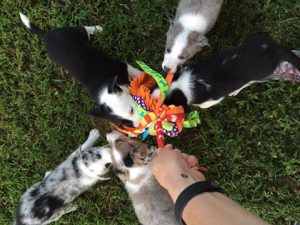
Adding a new pet to your family is a big decision. Pets bring balance, love, and an escape of sorts from our everyday stresses. Pets also bring us together and manage to teach us an awful lot. All dogs were originally bred for certain behaviors, (herding dogs herd, sight hounds run fast, etc) so do your research and make sure the breed of dog you are interested in has an activity level that will fit into your lifestyle. Dogs are not predisposed to behavior problems. Most behavior problems are due to inconsistent or lack of training from the beginning, and behavior problems are the most common reason dogs are left at pounds.
Puppies (and dogs) are not really that hard to manage if you remind yourself that you are dealing with the mind of a 2 year old and that training is a logical, progressive process that anyone can master with a little patience, humor, some high value treats and a lot of love. Spend the time when your dog is new and you will soon have a loving, well behaved member of your family.
Here are seven basic rules to help you manage the toughest puppy training challenges and ways to incorporate them into your daily activities:
Rule #1 Crate Train your dog.
Dogs are not spiteful. Dogs live in the moment. Chewing up your shoes or shredding the garbage was not done in spite because you left him home alone. Remember that 2 year old? Well he has got one powerful nose and if the garbage is accessible and something good and smelly was left inside, he is going to want to investigate. If you leave your new dog loose in your house, there is no telling what sort of mischief he may get into. A large new place, like your home, can be a bit overwhelming and even scary for a new dog to be left unattended in. Crate Training does not mean that your dog should / or will live the rest of his life in a crate. What it does mean, if done correctly, (lots of high value treats) is your dog will have a place where he can be feel safe and secure until he is mature and confident enough to handle a larger space unattended. Giving your dog a place that he can call his own also can help suppress separation anxiety, and speed along house breaking. Click here to learn more on how to crate train your dog.
Rule #2 Practice Redirecting
So your new pup wants to play, but your schedule is keeping you busy and the pup at your feet is getting in your way. This is a good time to redirect your pups attention to something that will entertain him, but allow you to get your tasks done. The easiest thing to redirect to is a chew toy. I use nylabones for this purpose, as they are safe (they don’t cause guarding in my multi-dog household) clean and easy. You may need to spend a few minutes interacting with him with the bone.. maybe toss it a few times, let him know how excited you are about this bone and how good it is to chew. You could also get an interactive toy that involves putting dog cookies or peanut butter inside and let him play with that for a while. Nylabones do seem drab and unexciting to some dog owners compared to other chew toys that are now on the market, but, they are much safer and healthier then processed rawhide or animal parts, and will last a lot longer. Read more about the best chews for your pup here.
Rule #3 Draw Boundaries

Puppies are cute, But when your 10 pound puppy grows into that 70 pound dog, are you still going to want him sitting on your lap? It is a whole lot easier to train a puppy correct behaviors from the beginning then it is to try to re-train that half grown dog. Boundaries can and should be established with the beginning of training, besides, once training begins, and the “lightbulb” goes off in your little dogs head that you are communicating and he will get a cookie if he responds correctly, learning will begin in earnest. So decide from the onset where your boundaries are. Are you going to let your dog on the furniture, or on the bed? Are you going to let him chase the cat or the children? Don’t know how to stop behavior that you don’t want.. Go back and review rule #1 and #2
Rule #4 Socialize your Pup
Everyone wants the perfect dog. One that will be friendly with visitors, yet bark at danger. A dog that will hang with the kids, and be ready to go for a jog. Your perfect dog is within your reach, but it is up to you to mold that “2 year old” into the solid citizen that he needs to become. Socializing your new pup allows him to meet other humans and dogs in new and exciting places. But the biggest benefit to taking your dog out to new places is the “bonding effect”. Your new dog is going through a lot of new experiences, hopefully by this time, he has learned that YOU are “nice”. He knows you feed him, you let him out, give him cookies, love him and you talk nice to him. When you are at a new place, You are his comfort, his trust and his safety. By taking him out into the world you have given him a big adventure with his new best friend. The more  adventures you have together, the more confidence he will gain in himself and the more trust he will gain in you.
adventures you have together, the more confidence he will gain in himself and the more trust he will gain in you.
Not sure where you can take him in your town? Look for farmers markets, dog friendly festivals, and outdoor supply stores. Make sure you are loaded with his favorite high value treats, and his favorite toy. And Please don’t forget to bring your common sense. Make sure your dog has a properly fitted collar (combo collars are good for new dogs) or harness, with proper ID on it, be prepared to clean up after your dog, and remember that not all dogs that you meet will be friendly, so ask the handler before you let your dog run up to any unknown dogs.
Rule #5 Be Consistent
As a perpetual 2 year old your dog is going to have a limited vocabulary, and even though dogs are champions at reading body language and tone, it is important to have consistent verbals when training. You do not have to use the words that everyone else uses, and you can certainly make your own words for communicating with your dog. For example, I use “This Way” while free walking my dogs on their daily walk, it keeps them with me without feeling that they have to be beside me.
One of the absolutely easiest things you can train your dog to do in your house, yard or out on an adventure, on lead or off, and quite possibly the most important thing he will ever learn is a recall. I carry dog treats with me 95% of the time. This allows me to call my dog and reward him whenever and wherever I can. For a new dog this may be 2 feet away and on a leash.. that is okay, if the dog looks at me and comes for a treat when I say “HERE” he gets a reward. Always practice this in a enclosed area at the beginning, eventually get someone to hold him while you increase your distance. Practice this often, ALWAYS, ALWAYS reward (eventually this reward will be just a “good dog”)
Rule #6 Create Motivation

Your dog should be exposed to different sorts of toys. Things to Chew, Things to fetch and Things to tug, shake and share. As he grows you will learn what toys are best for him and what toys he responds to. Eventually, you will notice that he may favor a certain toy, Maybe he really loves to fetch a ball, maybe its a frisbee, perhaps he Loves a game of tug with you. This favorite toy can also work for you as a motivational aid. This favorite toy may eventually be substituted instead of treats, and can be used as a reward for training tricks, dog sports, or any thing that you may need to teach your dog for his own safety. Be observant, and notice what toys really excite your dog. Take that toy with you on outings and use it when you need to get your dogs focus back on you or just to help him relax.
Rule #7 Enjoy
New dogs and puppies do not happen very often in our lives, and this new relationship should be looked upon as the special new beginning that it is. Have fun with your dog daily. Smile and laugh at the silly things that your dog does. He will love you with all his heart and You should love him back. Get help if you need it and if you really want to explore all that a new dog has to offer, take him to classes. There you will find others exploring relationships with their dogs, new friends and new dog friends.
I hope I have offered you some clues to make your new dog comfortable and your new position as caretaker enjoyable and full of positive fun. I Love talking dog and would love to hear about a special time in your relationship with your dog. Please leave me a comment.
Hi, Shelley.
Great post!
I have four dogs of varying ages, and I know first hand that having multiple dogs is nothing like having only one dog. Here are some of the difficulties I have experienced with my dogs.
(1) Aggression – One of my dogs seems to want to be the leader, and he bullies all the other ones. I have had problems where he actually attacks the smaller dogs, and I have had to separate them and keep him outside until he cools down. For some reason, thankfully, he has taken a liking to my smallest dog and is not aggressive toward her.
(2) Walking – I cannot walk all my dogs together because they will all pull in different directions and get all tangled up together. But I can’t walk just one either because they all get overly excited when the leash comes out and make it all but impossible to get out of the house. So, unfortunately we almost never take them for a walk.
Do you have any suggestions on how to deal with either of these?
Hi Andy, Yes, having multiple dogs can be challenging even for the most experienced dog owners. One of the most important things that I have realized is that I am outnumbered. So things like your dog walking issue is a great example of how our pack of dogs are always training us.. They feed of off each other and the excitement level can get daunting. I have the same sort of issue. when I let them off of the porch to run (actually they accompany me on my farm chores) .. they get super excited and basically stampede.. not safe .. especially for the smaller dogs, who tend to get run over.
I am VERY positive reinforcement based with my training and carry a lot of cookies (kibble works well in a pack… if it come from me…it must be good).. ..Changes happen slowly.. you know how hard it is to work with a pack… but how difficult it is to separate one out.. SO with a handful of “cookies” I have them all sit.. while waving my treats in front of their faces I carefully open the gate and as quick as possible start handing out cookies to whoever is still sitting… Usually once they realize that the cookies are done, they run, but it is a bit more organized and they remember that I have a pocket of cookies so are much more willing to recall . You mentioned how excited they get when you get the leashes out.. try to desensitize them to the leashes by getting them out .. a lot, every day.. move them around.. eventually put them on the dogs..if they act up.. take them off.. Remember to Only reward the behavior you want… NEVER behavior that you do NOT want. Think..”what do they want?” and How can your change/mold their behavior so they can get that.. If they behave they get a walk.. your new pocket of cookies will help keep them focused on you, if not.. get some HIGH VALUE treats.
Cookies can also help with your aggression issue, and these issues usually have something to do with the order in which the dogs came to you and their sex. I would enroll the bully in a basic obedience class.. this will help him feel special, will get him out and away for a break, and you should learn some calming and redirection techniques. ALWAYS be your dogs advocate and if you find an instructor that you do not like.. take your dog and leave.. A good instructor will never make you doubt their techniques.. and you will be able to take what you learn and use it for the good of the pack.. You will be a smarter pack leader!
I hope these tips can help you, You have given me some great ideas for future articles .
Good luck in your pack adventures
Shelley